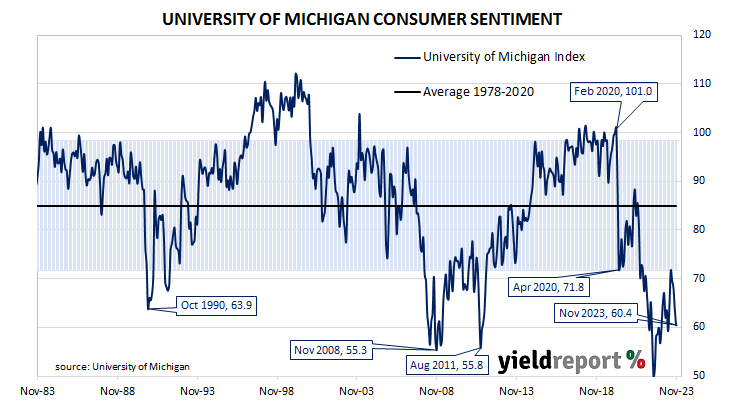Summary: University of Michigan consumer confidence index falls in November, less than expected; views of present conditions, future conditions both deteriorate; largest falls from lower-income consumers, younger consumers; Treasury yields generally rise; 2024 rate-cut expectations soften modestly.
US consumer confidence started 2020 at an elevated level but, after a few months, surveys began to reflect a growing unease with the global spread of COVID-19 and its reach into the US. Household confidence plunged in April 2020 and then recovered in a haphazard fashion, generally fluctuating at below-average levels according to the University of Michigan. The University’s measure of confidence had recovered back to the long-term average by April 2021 but then it plunged again in the September quarter and remained at historically low levels through 2022 and 2023.
The latest survey conducted by the University indicates confidence among US households has deteriorated for a fourth consecutive month. The preliminary reading of the Index of Consumer Sentiment registered 60.4 in November, less than the 63.5 which had been generally expected and down from October’s final figure of 63.8.
Consumers’ views of current conditions and their views of future conditions both deteriorated relative to those held at the time of the October survey.
“Overall, lower-income consumers and younger consumers exhibited the strongest declines in sentiment. In contrast, sentiment of the top tercile of stock holders improved 10%, reflecting the recent strengthening in equity markets,” said the University’s Surveys of Consumers Director Joanne Hsu.
US Treasury bond yields generally rose on the day, although ultra-long yields declined a little. By the close of business, the 2-year Treasury yield had gained 5bps to 5.07%, the 10-year yield had added 2bps to 4.65% while the 30-year yield finished 1bp lower at 4.76%.
In terms of US Fed policy, expectations of a lower federal funds rate in 2024 softened modestly. At the close of business, contracts implied the effective federal funds rate would average 5.345% in December, 2bps more than the current spot rate, 5.355% in January and 5.375% in March. November 2024 contracts implied 4.775%, 56bps less than the current rate.
It was once thought less-confident households are generally inclined to spend less and save more; some decline in household spending could be expected to follow. However, recent research suggests the correlation between household confidence and retail spending is quite weak.


